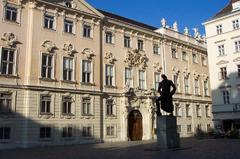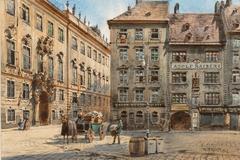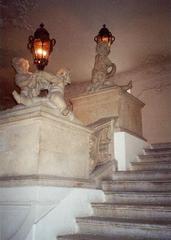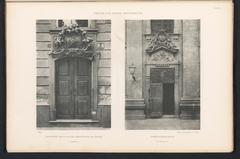
Bohemian Court Chancellery: Visiting Hours, Tickets, and Guide to Vienna’s Historical Legacy
Date: 14/06/2025
Introduction
The Bohemian Court Chancellery (Böhmische Hofkanzlei), located at Judenplatz 11 in Vienna’s Innere Stadt, stands as a remarkable testament to Central European history and the administrative legacy of the Habsburg Monarchy. Designed by the celebrated Baroque architect Johann Bernhard Fischer von Erlach and completed between 1709 and 1714, this imposing structure once served as the nerve center for governing the Kingdom of Bohemia and its lands. While its interior is now used for judicial functions, the building’s grand exterior and its central setting on Judenplatz make it a highlight for anyone exploring Vienna’s imperial past.
Today, the Bohemian Court Chancellery offers visitors an opportunity to connect with Vienna’s rich architectural and political heritage. Its proximity to other major sites—like St. Stephen’s Cathedral, the Hofburg Palace, and the Jewish Museum—further establishes it as an essential stop on any historical tour of the city. For those seeking a deeper understanding, the Audiala app provides engaging audio guides and detailed maps to enhance the experience.
For the latest visitor information and event updates, consult the Vienna Tourism website and the Austrian Constitutional Court.
Table of Contents
- Historical Overview
- Architectural Highlights
- Visitor Information
- Travel Tips
- Nearby Attractions
- Frequently Asked Questions (FAQ)
- Conclusion and Resources
Historical Overview
Origins and Role in the Habsburg Monarchy
The Bohemian Court Chancellery was established in the early 16th century and, after the Habsburgs consolidated power, became the central administrative authority for the Kingdom of Bohemia and its crownlands. Originally situated in Prague, the Chancellery was moved to Vienna in the late 17th century to streamline imperial governance. Under the Habsburgs, it managed legal, fiscal, and administrative affairs for Bohemia, Moravia, Silesia, and Lusatia, playing a crucial role in integrating these regions into the empire.
Political and Administrative Importance
The Chancellery was pivotal in enforcing imperial laws, handling taxation, and mediating between the central monarchy and regional estates. It became especially significant during the reforms of Maria Theresa and Joseph II, acting as an agent of both modernization and imperial centralization. As the balance between imperial authority and regional autonomy shifted, the Chancellery became a key institution in Vienna’s political landscape until its dissolution in 1849.
Architectural Highlights
Baroque Design and Key Features
Johann Bernhard Fischer von Erlach’s design for the Bohemian Court Chancellery epitomizes Viennese Baroque architecture. The building’s grand symmetrical façade, elaborate stucco, and monumental entrance reflect both its administrative authority and the prestige of the Bohemian lands. Four allegorical statues on the façade represent moderation, wisdom, justice, and bravery, while heraldic Bohemian lions underscore its identity.
Later Modifications
Between 1751 and 1754, architect Matthias Gerl expanded the building, doubling its size and adding another grand staircase while maintaining stylistic coherence. Despite 19th-century renovations and damage in World War II, the building retains its original Baroque character.
Symbolic Decoration
The façade features intricate ornamentation, pilasters, and statues of Bohemian kings, alongside an angel with a trombone—symbols of justice and authority. These details reinforce the building’s dual role as both a regional and imperial seat of power.
Interior Heritage
While the interior is largely inaccessible to the public due to its current function as the seat of the Austrian Constitutional and Supreme Administrative Courts, key Baroque elements—including the main staircase and ceremonial halls—have been preserved and occasionally opened for special events.
Visitor Information
Location and How to Get There
- Address: Judenplatz 11, 1010 Vienna
- Public Transport:
- U-Bahn: Stephansplatz (U1, U3)
- Trams: Lines 1, 2
- Nearby bus and tram stops provide easy access to the historic district.
Visiting Hours and Ticketing
- Regular Access: The Chancellery’s exterior is open to public viewing at any time. The building itself is generally closed to visitors except during special events (e.g., European Heritage Days).
- Tickets: Entrance for guided tours or special events may require tickets, which are typically available online or at event locations. No ticket is required to view the exterior.
- Guided Tours: Tours are occasionally offered in English and German during cultural events. Advance booking is recommended. Check the Vienna Tourism website for updates.
- Accessibility: The surrounding Judenplatz is wheelchair accessible. For interior access during events, contact organizers regarding specific accommodations.
Amenities and Services
- Restrooms and Cloakrooms: Available in nearby museums and cafés.
- Tourist Information: Centers at Albertinaplatz, Hauptbahnhof, and the airport provide maps, guidance, and booking services (Vienna Tourist Bureau).
- Audio Guides: The Audiala app offers in-depth audio content and walking maps for Vienna’s historic sites.
Travel Tips
- Visit early in the morning or late afternoon for optimal lighting and fewer crowds.
- Wear comfortable shoes to explore Vienna’s pedestrian-friendly historic center.
- Respect the solemn atmosphere of Judenplatz, especially near the Holocaust Memorial.
- Combine your visit with nearby attractions, such as St. Stephen’s Cathedral, the Jewish Museum, and the Hofburg.
Nearby Attractions
Expand your exploration with these nearby highlights:
- St. Stephen’s Cathedral
- Hofburg Palace
- Jewish Museum Vienna
- Museum am Judenplatz
- Austrian National Library
Frequently Asked Questions (FAQ)
Q: Can I visit inside the Bohemian Court Chancellery?
A: The interior is generally not open to the public, except during special events. Exterior viewing is always possible.
Q: Are there guided tours?
A: Guided tours are offered only during select events. Check the Vienna Tourism website for current schedules.
Q: Is the building accessible?
A: The area is accessible for those with mobility needs, but interior access varies during events.
Q: Do I need tickets?
A: Exterior viewing is free; tickets may be required for special events or tours.
Q: What are the best nearby attractions?
A: Hofburg Palace, St. Stephen’s Cathedral, the Jewish Museum, and Museum am Judenplatz are all within walking distance.
Conclusion
The Bohemian Court Chancellery is a vital link to Vienna’s imperial and architectural legacy. Even with limited interior access, its Baroque façade, symbolic statues, and central location on Judenplatz provide visitors with a vivid sense of the city’s history. Enhance your visit by exploring nearby landmarks and using tools like the Audiala app for a richer, more informative experience.
For up-to-date information on opening hours, tickets, and special events, consult official resources:
Sources and Official Links
- This article draws on official visitor information from Vienna Tourism - Bohemian Court Chancellery, Austrian Constitutional Court, and Hofburg Palace.
For more Vienna travel tips, historical site guides, and downloadable audio tours, stay connected through our social media channels and the Audiala app.

























































































































































